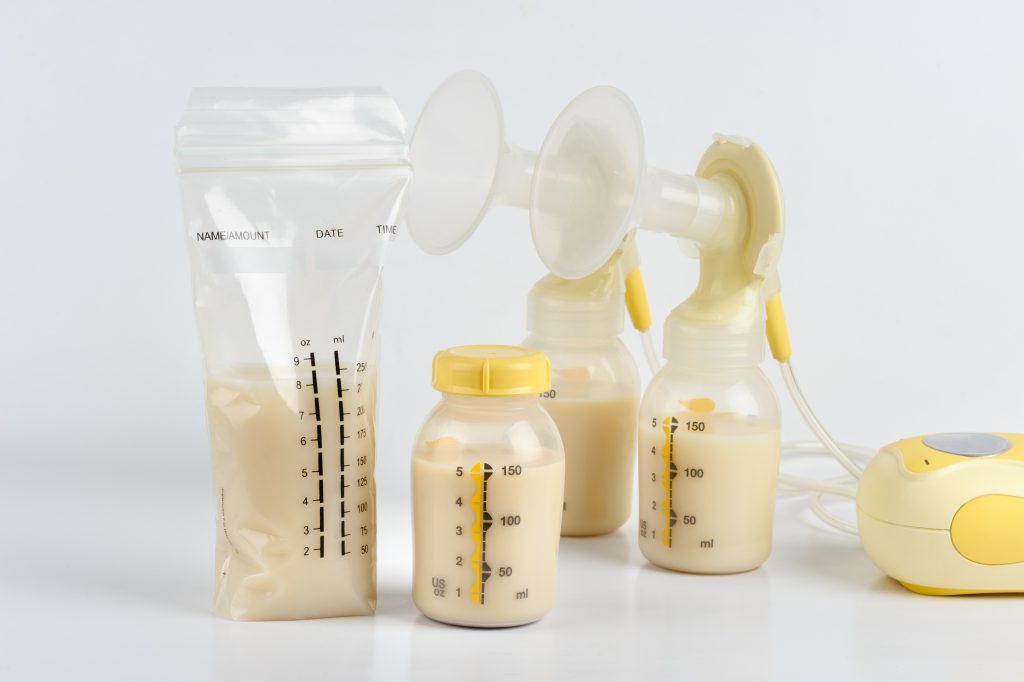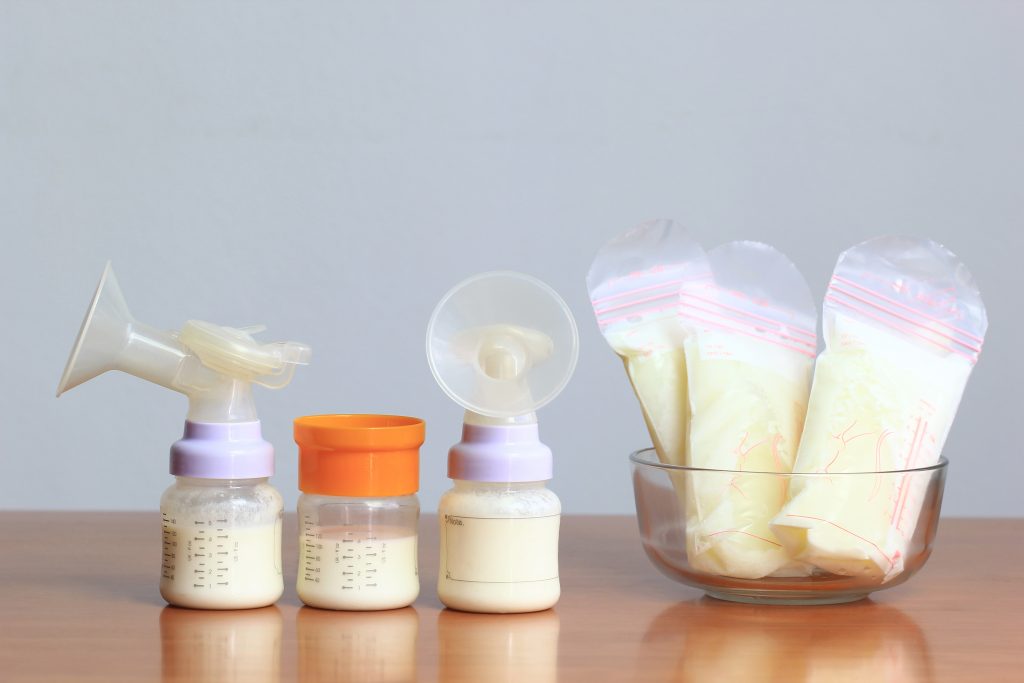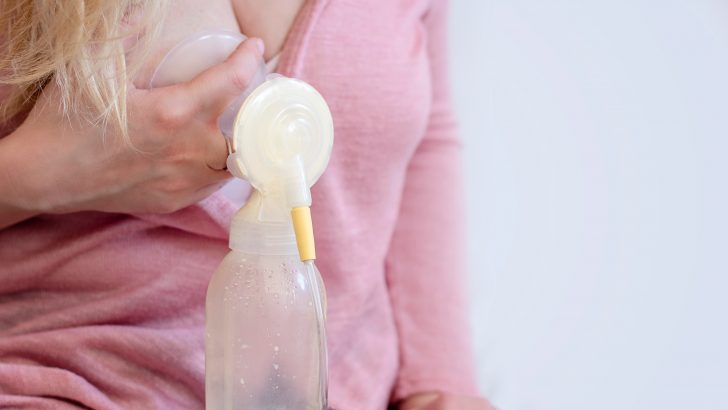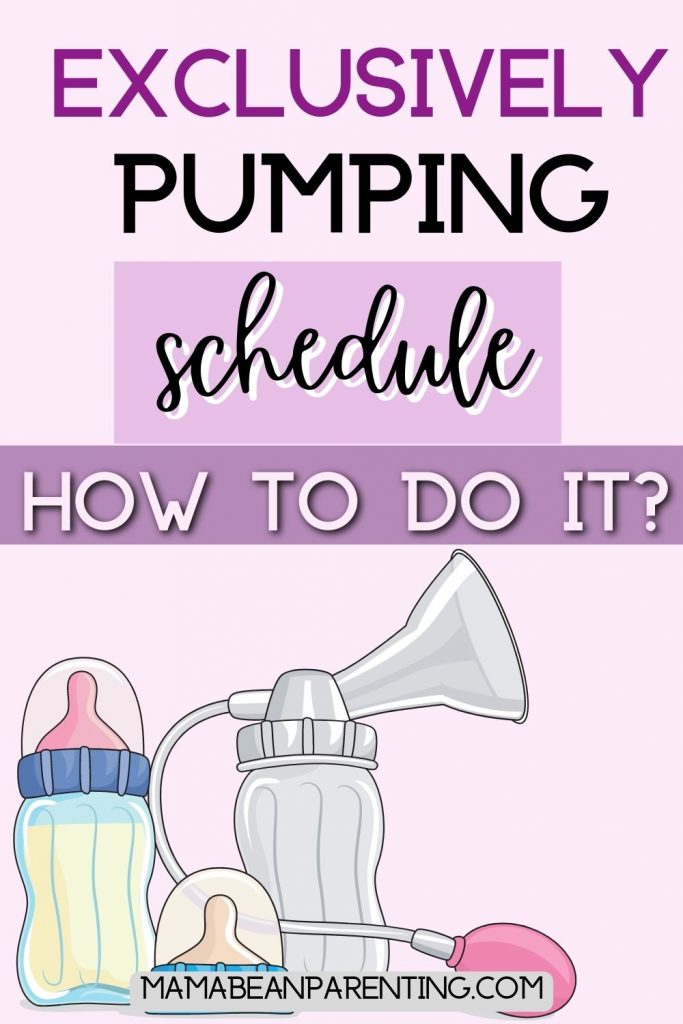As a first-time mum, you’ve probably just heard about the exclusively pumping schedule, and you’re not too sure what it represents.
Don’t worry. A lot of new moms are confused about the exclusively pumping schedules as well.
Below, I will try to explain everything regarding these schedules, starting from the basic definition regarding exclusively pumping schedules and so much more.
So stay tuned!
What Is Actually Exclusively Pumping?

There’s a term called exclusive pumping, also known as EPing, which means you have decided to give your newborn only breast milk that you pump or express.
In these instances, newborns are given breast milk by NG tube, bottle, or other things instead of straight at the breast.
Generally speaking, this is a good alternative for a lot of mothers (especially the ones who are not interested in breastfeeding).
However, it’s worth mentioning if you want to do this whole exclusively pumping schedule, you need lots of strength and dedication. But it’s worth a try!
Even if you are not breastfeeding your baby in a traditional way, don’t forget that your milk is essential to your little one, and there are ways to make your milk fattier.
That’s why it’s pivotal to establish a solid routine for an exclusively pumping schedule.
Why Do Women Tend to Choose Exclusively Pumping Schedules?
I would like to remind every mother out there that she doesn’t need to feel guilty about the way she is feeding her little angel. She is doing her best to make sure her baby is happy!
Some mothers even combine breastfeeding and pumping. And that’s OK too!
And this doesn’t refer to the ladies who decided to opt for an exclusively pumping schedule (instead of breastfeeding), but to every single mom in the world.
Even if you are the first one in your family who does this, remember that you, for sure, are not the only one in the universe.
In fact, there are a lot of women who decide to have their own exclusively pumping schedule for a variety of different reasons.
What are the most common ones?
1. Low-birthweight, preterm, or hospitalized baby
2. Latch issues, for instance, baby refusing your breast, pain on latch-on, shallow latch, tongue-tie, lip-tie, inverted nipples, and many others.
3. Lack of support or early breastfeeding issues
4. Twins and multiples
5. You’ve been separated from your infant
6. You must work, which is why you need help from others
7. History of sexual abuse
8. You do not feel comfortable breastfeeding
9. You wish to supervise the baby’s milk intake and schedule feedings
10. You are under a lot of stress
As you can see, there are so many different reasons why new moms turn to an exclusively pumping schedule, so there’s no need to criticize yourself for doing the same.
Exclusively Pumping Schedule – How Often Should You Pump?
This is probably one of the most common questions regarding exclusively pumping schedules.
From what I know, you should opt for exclusive pumping as often as possible because only then will you be able to establish and maintain the milk supply.
Exclusive pumping is crucial in the first few months. I would suggest including your exclusively pumping schedule in at least seven to ten exclusive pumping sessions each day so your baby gets enough breast milk.
How many sessions you will have during your exclusively pumping schedule mostly depends on several circumstances.
For instance, if you realize that you are not pumping as much as your baby needs, then it would be best to have at least nine to ten exclusive pumping sessions daily.
On the flip side, if you have older kids or twins (which can often be very tiresome), then it’s okay if 7 sessions are on your exclusively pumping schedule.
As your little one gets older, feel free to modify your exclusively pumping schedule, and if it’s necessary, you can pump less frequently.
How Long Are You Supposed to Pump for?

If you’re determined to stick to your exclusively pumping schedule, then you should pump for at least two hours per day.
To figure out how long you should be doing this, for every single pumping session, divide 120 by the number of times that you are pumping and then make sure to set that as your goal.
For instance, if you pump 8 times every day, make sure to pump for fifteen minutes at a time.
I would like to remind you that it’s completely okay if you pump for more than two hours. However, just be sure you are not stressing yourself too much physically.
In addition, it would be best to pump for your full pumping time even if the milk no longer flows.
Why is that?
Firstly, that’s because your milk may fail you again, enabling you to pump more milk.
Secondly, nipple stimulation is going to safeguard your milk supply long-term potentially.
When Are You Supposed to Pump?
There are several ways to determine when are you supposed to pump.
1. You should pump whenever you notice that your little one is hungry
2. If you’ve created an exclusively pumping schedule, then pump at designated times each day.
Both of these alternatives come with certain advantages.
Namely, if you’ve created an exclusively pumping schedule, it means that you know exactly when it’s time to pump so you can plan everything accordingly.
On the other hand, pumping when your newborn is eating it is a great way to be sure that you are pumping enough.
Not to mention the fact that it gives you some time in between feeding and pumping to do whatever your heart desires and get the proper rest.
Is It Mandatory to Stick to an Exclusively Pumping Schedule?
I mean, it’s not necessary to stick to an exclusively pumping schedule. However, most mothers decide to stick to the pumping exclusive schedule. This simply works for them.
And that’s mostly because they love having a routine, plus it’s something that prevents leaks and aids in milk supply.
In addition, sticking to an exclusively pumping schedule is going to help you be consistent with getting every pumping session completed throughout the day.
However, if you notice that your exclusively pumping schedule no longer works for you, then, of course, you are not obligated to pump on a schedule. The point is to do something as long as it works for you.
Once that’s not the case, then turn to something else.
I would just like to remind you that there are numerous benefits of sticking to an exclusively pumping schedule, and they include the following:
1. A breast-pumping schedule will help you maintain your milk supply.
2. Your body will get used to refilling your milk supply at a particular time.
3. I’ve read a bunch of times that lots of mothers have an easier time in terms of letdowns if they stick to a schedule.
4. You can avoid leaking if you go too long between sessions.
What to Do if You Miss a Pumping Session?
If by any chance you miss a pumping session, then the best thing you can do is pump as soon as you can.
For instance, if your schedule (concerning pumping) is normally at 2 pm and 7 pm, and for various reasons, you skip the 2 pm pumping session, then simply begin your next pump at 3 pm.
And then just get back on schedule by starting your next pump at 7 pm.
Even though these things can happen to anyone unless you want to produce less milk, be s sure not to turn this into a habit.
Why is that?
Well, that’s because you increase the chances of a drop in your milk supply if you frequently skip your pumping sessions.
Do You Need to Pump At Night?

According to the mothers I’ve talked to, if you’ve decided to opt for exclusively pumping, then yes, you should pump at night as well before you go to sleep.
A general rule of thumb is to check out to see if your infant is eating from the bottle during the night.
If that’s the case, then you should use the pump for each bottle feeding.
I know that, at times, it can be pretty tricky to keep up with these sessions, particularly in the first couple of months when you’re tired from caring for your baby and you just want to sleep.
However, I would still like to remind you that it’s essential to keep up with the middle-of-the-night session, especially now that you are trying to establish your milk supply.
This is usually from birth up until twelve weeks postpartum.
A lot of moms decide to keep up the middle with the middle-of-the-night pumping session because that’s precisely the time when they produce lots of milk.
How Much Milk Should You Be Making?
In a perfect world, at every single pumping session, you should get enough (maybe even more) for the baby’s next feeding session.
However, since we do not live in an ideal world, things do not always turn out that way.
Bear in mind the amount exclusive moms produce tends to vary a lot.
For example, some moms will get roughly 4 oz for their infants, while others will get a couple of drops.
But I would just like to remind you that you should never blame yourself if you do not pump as much milk as you expected.
However much milk you produce, at the end of the day, you are still doing an amazing job! So don’t forget that!
How Much Breast Milk With Your Newborn Need?
According to my findings, most newborns have around 1.5 to 3 oz per feeding, which is approximately 20 to 25 ounces each day.
The same rule can be applied here (just like with your milk supply), meaning that these things can vary too.
For example, if your baby is relatively big, then you’ll use a lot more milk in comparison to a smaller baby.
Is it Okay to Pump Exclusively as Soon as Your Baby is Born?

Yes, that’s completely okay. If you’re planning this route, then keep in mind that there are some steps that you will need to take to make sure you produce the right amount of milk:
1. Before birth – Do your homework and then order what you will need to use upfront (roughly around 35 weeks of pregnancy).
You can obtain a consumer-grade pump free of charge with health insurance; however, you can also rent a hospital-grade pump because it’s more effective.
2. Within the first hour after your infant is born: Hand express the colostrum as quickly as you can and demand pumping support from the hospital.
3. Day 1: Hand express the colostrum often (every one to three hours). It’s frequently easier than employing a breast pump.
4. Day 2: Opt for a hospital-grade electric breast pump, pumping both breasts simultaneously, at least ten times in one day until you are absolutely sure you have a lot of milk for your newborn.
5. In the early months: You will most likely need to pump enough in order to keep you with the baby’s needs for breast milk, which is a bit different from newborns who eat formula.
Generally speaking, infants nurse from the breast approximately eight to twelve times a day on average, which means that you’ll be having a lot of nighttime pumping sessions.
More Information About Exclusive Pumping Schedule
Mothers who decide to opt for an exclusively pumping schedule can create a schedule that suits them the most.
The point is to establish a full milk supply of around 25 to 35 ounces per day on average.
What are the factors that you should take into account in terms of an exclusive pumping schedule?
• Pump for more than ten minutes once your milk supply increases. Just don’t pump for longer than twenty minutes at a time.
Most mothers have concluded that pumping for around two minutes after the last drop of milk is an effective way to encourage more milk.
• You can use an app because there are a plethora of great apps for it on the market. Namely, some mums determine how many times they want to pump in one day, and then they employ an app to track the number of times they pump.
It also wouldn’t hurt to show this to your pediatrician during your visits.
• Take inventory of your support system and the newborn’s sleep schedule. I mean hardly any mom sleeps when their baby is sleeping, am I right?
Even if there are mothers out there who do that, I am positively sure that that’s not the case with an exclusively pumping mother.
When you are developing your baby’s pumping schedule, try to think about the time when you know you will have support too, allowing you to pump even if your baby cries, needs to be entertained, changed, etc. You get the point.
Excellent Exclusive Pumping Tips
Now, that we covered some of the most essential tips regarding exclusive pumping, below I will provide you with some amazing exclusive pumping tips, then will help you exclusively pump your breast milk.
1. You can always rent a hospital-grade breast pump – If you want to exclusively pump your breast milk, then you should definitely opt for this one. These are also known as high-efficiency double-electric pumps.
Where can you find them? These exclusive pumpers can be found relatively easily, however, if you do not have the slightest idea where you can hunt them down, then just ask your pharmacy, hospital, or local breastfeeding support center.
Generally speaking, these pumpers can be very pricey, which is why it’s recommendable to rent them instead.
Consumer-grade pumps that can be found in stores (and are normally provided by insurance companies) are designed with the purpose to increase milk supply and supply pumping.
2. Set up an in-house pumping and sanitizing station – The biggest risk when you decide to pump exclusively is contamination.
Your sink will probably be packed with things, with all the bottle and pump parts that must be cleaned. Some mothers tend to purchase additional pump parts to avoid constant cleaning after each session.
As you can see, these super moms are always one step ahead, which is why you should be like them as well, if you want to streamline this entire process.
That’s particularly important when you’re tired from all the chores and tasks you have during those 24 hours.
3. Store properly – Various guidelines will tell you exactly how to store your breast milk safely. So if you want to store and freeze your breast milk correctly, then be sure to go through them.
4. Don’t forget to acquire solid breast shields (flanges) – Each pump has several flange sizes, ranging from twenty-one to thirty-seven millimeters.
However, if they are not working for you, then consider other ones.
Many mothers with bigger nipples think that a conventional-size flange is too small for them. If you have the same problem, then the best thing that you can do is to order a different size.
That’s something that can be done either on the internet or by going to the nearest breastfeeding support center.
5. Taking care of yourself is a must! – I know that your priority is to feed your baby and keep it happy and healthy. However, please do not forget that you matter as well.
Therefore, you should take at least 20 minutes (or more if you can) to take a shower, eat, drink, and above all have some rest.
Since you are feeding your child by using a bottle, it means that anyone can do it while you are taking some time to unwind. Remember, your baby needs you to be happy and healthy, so please take care of yourself.
6. Ensure your pumping sessions are entertaining, too – I know that exclusive pumping can sometimes be very exhausting; hence you should do something that you generally love while pumping.
You can, for instance, watch your favorite TV show or series, play on your cell phone, listen to some relaxing music, etc. The point is to use this time to take a break from all the obligations you have daily.
What Setting Should You Set Your Pump to?
I know that a vast majority of mothers find this to be very confusing. However, there are a few things that you should focus on:
Many breast pumps come with two modes – letdown/massage mode (which can be fast and light) and expression mode (which comes with higher suction and slower).
Most of these pumps instantly switch from letdown mode to expression mode after maybe one minute or two.
When you are pumping, you are supposed to set the vacuum strength to the speed that is comfortable for you.
And then gradually move it up to a higher suction until you are no longer feeling comfortable and then you can dial it back one setting. This is usually the ideal suction for you.
I mean, there’s no such thing as the right setting for cycle speed.
What may come as a surprise for you is the fact that some pumps do not even come with that setting.
Therefore, I would advise you to experiment for a bit just to see what suits you the most.
How Long Can You Exclusively Pump?
The length that you opt for can vary. However, the American Academy of Pediatrics (AAP), suggests that newborns should exclusively drink breast milk in the first 6 months.
And then you can slowly add solid foods to their diet. Of course, you will need to continue pumping while weaning your little one. However, your sessions do not have to be as frequent.
In addition, the length of time you decide to pump will depend on how powerful your exclusive pump schedule is.
Some moms have more time to pump in comparison to others, which means that they will have a more intense exclusive pump schedule.
Conclusion

I’m not going to lie to you. I know that exclusively pumping can be very physically demanding, particularly initially, until you establish the right amount of milk supply.
You get a feeling like you are literally chained to the exclusively pumping schedule and that there’s no way out.
But don’t worry. As time goes by, things will get easier and everything that you’ve gone through so far will be a thing of the past.

Well, hello there!
My name is Jennifer. Besides being an orthodontist, I am a mother to 3 playful boys. In this motherhood journey, I can say I will never know everything. That’s why I always strive to read a lot, and that’s why I started writing about all the smithereens I came across so that you can have everything in one place! Enjoy and stay positive; you’ve got this!



Elastic Nipples: All You Need to Know • Mama Bean Parenting
Monday 24th of April 2023
[…] Pumping is a great way to make sure your baby has enough milk all the time, but some women encounter unusual obstacles when they start to pump – such as elastic nipples. […]
When Can I Stop Pumping At Night? • Mama Bean Parenting
Tuesday 21st of March 2023
[…] Many moms are only pumping breast milk, and they make their exclusively pumping schedules. […]
All You Need to Know About Spectra Pump Settings • Mama Bean Parenting
Saturday 4th of March 2023
[…] This is particularly true with exclusive pumpers because they tend to be overused. Therefore, experts suggest replacing your pump parts by relying on the following time frames: […]